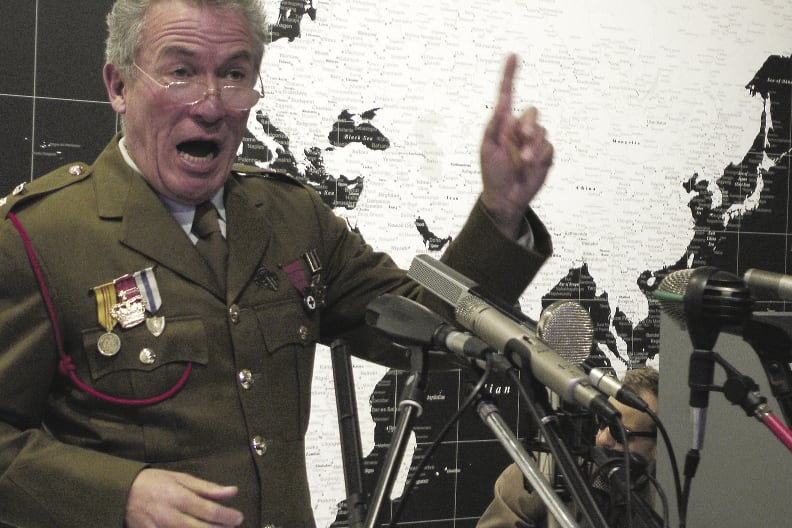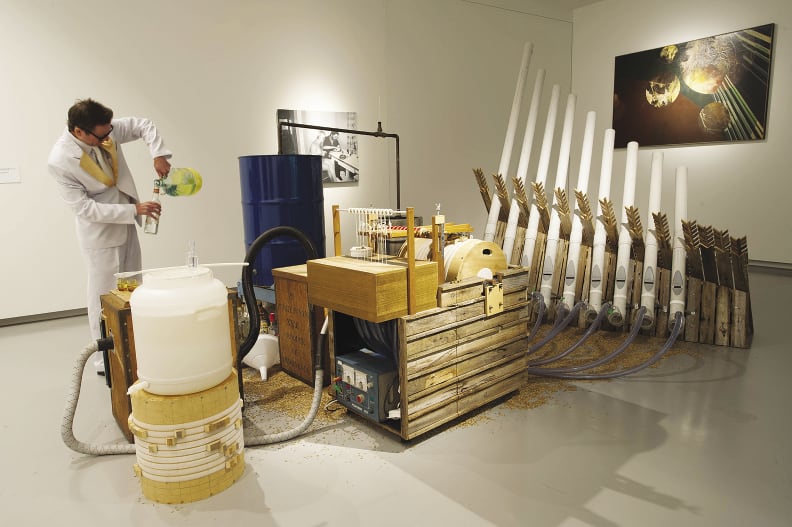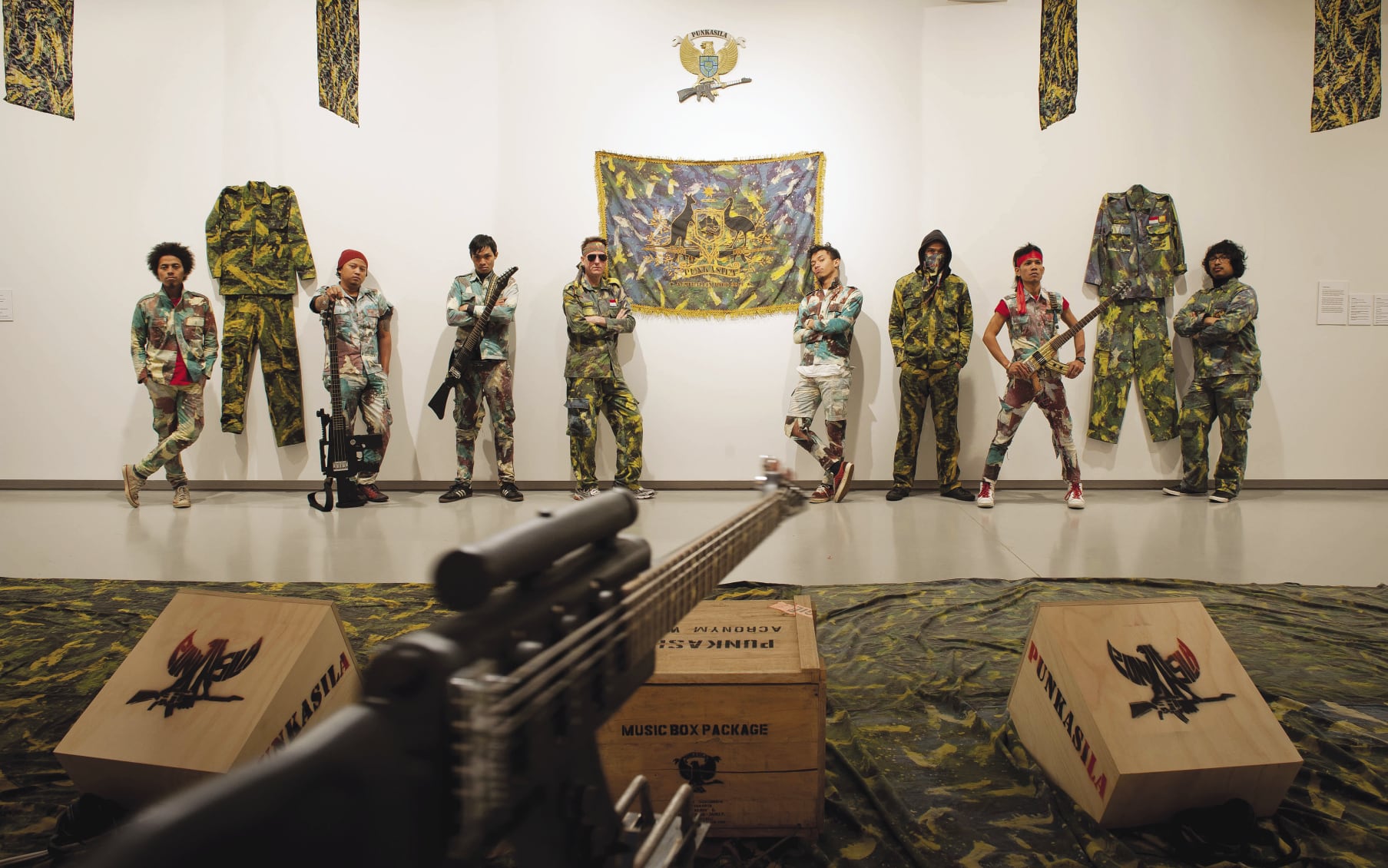Three projects by Danius Kesminas and collaborators
Monash University Museum of Art, Melbourne
5 May – 23 July 2011
Curated by Max Delany

Visually, Danius Kesminas’s three projects included in Monash University Museum of Art’s survey show — covering his work with a varied cast of collaborators over the last decade — defied viewers to look for commonalities. The discrete quasi-judicial space of Slave Pianos gave way to the grunge militarism of Indonesian rock band Punkasila’s machine-gun guitars and large-scale Bollywood-influenced banners. Wood-carved folk motifs decorated the door to a third and final room, where a -functioning vodka still-cum-pipe organ played a doleful Lithuanian drinking tune.
But beneath the surface of this most ambitious and satisfying of exhibitions lay a series of contiguous interests, concerns and productive motivations. Music was only the most obvious. Kesminas orchestrated a ‘choreography’ of music, art and performance alloyed with intensive, multi-disciplinary, ‘border-crossing’ collaborations that provide a model for post-individual artistic practice. Working alongside people with a range of backgrounds and skills has made possible an impressive range of conceptual, technical and design-based outcomes that would have been difficult for a single person to achieve. These knowledge sets furthered investigations in archival and folkloric research, distribution networks both literal (Fluxus and the transnational vodka pipelines documented as part of the Pipeline to Oblivion project) and semantic (Slave Pianos’ translation and reinscription for pianola of visual artists’ music projects and Punkasila’s creative misappropriation of Indonesian acronyms and initialisms) and, in prominent theorist John C Welchman’s analysis in his brilliant catalogue essay, a laying bare of the cultural construction of abbreviation and reductionism.
Slave Pianos was formed in 1988 by Kesminas, Rohan Drape, Michael Stevenson and Neil Kelly, and also includes Dave Nelson. The group’s core business is the subjection of a geographically and historically diverse range of visual artists’ music projects to a process of translation and transcription; for example, an early ‘anti-music’ piece by John Nixon may be transcribed for pianola (the player — or slave — piano is the group’s exemplary instrument but they have also worked with a range of approaches, from chamber orchestras to turntablists). It is a forced fit, where dissonance, experimentation and non-standard instrumentation are neutered in order to, in Kesminas’s own words, return the avant-garde to the conservatorium.
At MUMA, The execution protocol: Mutually assured production (The MAP room) III 2007–11 presented a parlour-grand piano strapped to an oversized electric chair. The protocols consisted of selections from the Slave Pianos repertoire executed by a piston-machine (converting the baby grand to a pianola) that pummeled the ivories in response to audience selections on a retro-looking console whose Get Smart-Cold War aesthetics were borne out by a gloriously over-the-top final-day performance starring actor Richard Piper as an artistically minded Eastern European army general suffering from a Dr Strangelove-like monomania. The performance saw the piano sentenced to death and the execution presided over by an honorary member of the Punkasila junta; a wake was held in the Lithuanian-inspired vodka room.
Punkasila are a rock band; a collaboration between Kesminas and a group of young Indonesian artists and musicians he met while on an Asialink residency in Yogyakarta in 2006. The group combine a cogent critique of post-reformasi Indonesian society with dirty-mouthed bubblegum anarchy. They’re known for their batik-augmented combat fatigues, hand-crafted electric guitars in the shape of assault rifles and hi-energy ‘post-disaster rock’ songs with lyrics based entirely on repurposed Indonesian military and government acronyms (so that, for example, RPKAD — the army’s former special forces group — begets the song Rampung Kenthu Anake Duwekmu [Let’s Have Sex! But The Child Will Be Yours]). Punkasila performed twice at Melbourne rock venues as well as facilitating the museum installation of banners, videos and machine-gun guitars. An array of T-shirts, comic books and zines made available in a hallway vitrine and at the MUMA book store were all part of a range of artistic strategies the various members of the group bring to their undertaking.

The third project, Pipeline to Oblivion, offered insight into the vectors of Kesminas’s Lithuanian culture — and the vodka belt countries of Eastern Europe in general — through the distorted lens of a shot glass. As well as the outlandish still-organ mentioned earlier, the room contained posters and a video documentary relating to Kesminas’s Vodka Sans Frontières project, his investigation of a large DIY network of underground pipes discovered in 2004 and designed to transport bootlegged vodka into Lithuania. The canalisation (forced-fitted reductionism in Welchman’s schema) represented by the pipes is a direct result of the people’s competing urge for physical abandon and drunkenness.
In what I am confident amounts to one of the most significant exhibitions in Australia of 2011, Kesminas and collaborators have successfully mapped ‘execution protocols’ for folk-based lines (in the musical sense) with macabre motifs of death, anarchy and ruinous alcoholism. This is not done for shock value, or in a celebration of cynicism or pessimism, but as a process of knowledge production based in experimentation, research, performance and a testing of the limits of what might be thought of as a social epistemology based in various vulgar or popular forms, of which art, music and clear spirits just happen to be some of the most easily soluble.
Dylan Rainforth is the deputy editor of Art Guide Australia and the writer of The Age’s weekly art news column SPACE.

